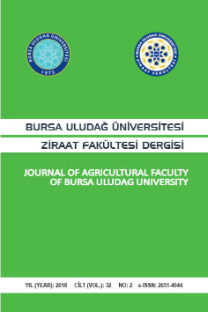Tavuk ve horozların gelişme sürecinde hipofiz bezi pars distalisinin histolojik yönden incelenmesi
biyolojik gelişim, bazofil, kümes hayvanları, hipofiz bezi, yumurta tavuğu, horoz, doku bilimi
Histological investigations on the pars distalis of the pituitary gland of hens and cocks during the developing period
___
1. BARABANOV VM. Detection of Prolactin in the Hypophysis of the Chick and Chick Embryo. Ontogenez 1985; 16(2): 118-26. 2. BASTINGS E, BECKERS A, REZNIK M, BECKERS JF. Immunocytochemical Evidence for Production of Luteinizing Hormone and Follicle- Stimulating Hormone in Separate Cells in the Bovine. Biol Reprod. , 1991; 45:788-796. 3. BERGHMAN LR, GRAUWELS L, VANHAMME L, PROUDMAN A, FOIDART A, BALTHAZART J, VANDESANDE F. Immunocytochemistry and Immunoblotting of Avian Prolactins Using Polyclonal and Monoclonal Antibodies Toward a Synthetic Fragment of Chicken Prolactin. Gen. Comp. Endocrinol. 1992; 85(3): 346-57. 4. CROSSMONN G. A Modification of Mallory's Connective Tissue Stain with a Discussion of the Principles Involved. Anat. Rec. 1937; 69: 33-8. 5. DACHEUX F, DUBOIS MP. Ultrastructural Localization of Prolactin, Growth Hormone and Lutenizing Hormone by Immunocytochemical Techniques in the Bovine Pituitary. Cell and Tissue Research. 1976; 174: 245-260. 6. DELLMANN HD .Endocrine System. In: DELLMANN HD, EURELL A, eds. Textbook of Veterinary Histology. Fifth Edition, Williams&Wilkins, USA, 289-93, 1998. 7. FARNER DS, KING JR, PARKES KC. Avian Biology. Volume III, Acedemic Pres, New York, 128-148, 1973. 8. GUEMENE D, WILLIAMS JB. LH Responses to Chicken Luteinizing Hormone-Releasing Hormone I and II in Laying, Incubating and Out of Lay Turkey Hens. Domes. Anim. Endoc. 1999; 17, 1-5. 9. HARVILLE DA, CALLANAN TP. Estimation of Genetic Parameters. In: GIANOLA D, HAMMOND K, eds. Advences in Statistically Methods for Genetic Improvement of Livestock: Springer - Verlag, 135 – 171, 1990. 10. HATTORI A, ISHII S, WADA M. Different Mechanisms Controlling FSH and LH Release in Japanese Quail (Caturnix Coturnix Japanica): Evidence For an Inherently Spontaneous Release and Production of FSH. J. Endocrinol. 1986; 2: 239-45. 11. HODGES RD. The Histology of the Fowl, Academic Press, London, 429-431, 1974. 12. IWAMA Y. Immunohistochemical Identification of Mouse Adenohypophysial Gonadotropes. Okajimas Folia Anat Jpn. 1990; 67:281-87. 13. KANSAKU N, SHIMADA K, SAITO N. Regionalized Gene Expression of Prolactin and Growth Hormone in the Chicken Anterior Pituitary Gland. Gen Comp Endocrinol, 1995; 99 (1): 60-8. 14. KRISHMAN KA, PROUDMAN JA, BAHR JM. Purification and Characterization of Chicken Follicle- Stimulating Hormone. Comp. Biochem. Physiol. 1992; 1: 67-75. 15. LIU R, LEA RW, SHARP PJ, MAXWELL MH. Ultrastructure of Lipid-Containing Cells of the Anterior Pituitary Gland of the Domestic Chicken, Gallus Domesticus. Anac. Rec. 1993; 237: 506- 511. 16. MIKAMI S. Morphological Studies on the Avian Adenohypophysis Related to Its Function. Gunma Symp. Endocrinol. 1969; 6:151-170. 17. MIKAMI S, KUROSU T, FARNER DS . Light and Electron Microscopic Studies on the Secretory Cytology of the Adenohypophysis of the Japanese Quail, Coturnix Coturnix Japanica. Cell And Tissue Res. 1975; 159 (2):147-65. 18. OTTINGER MA, BAKST MR. Endocrinology of the Avian Reproductive System. J Avian Med Sur.1995; 9(4): 242-250. 19. PROUDMAN JA, VANDESANDE F, BERGHMAN LR. Immunohistochemical Evidence That Follicle-Stimulating Hormone Reside. In the Chicken Pituitary. Biology of Reproduction., 1999; 60:1324-1328. 20. RAMESH R, PROUDMAN JA, KUENZELWJ. Changes in Pituitary Somatotroph and Lactatroph Distribution in Laying and Incubating Turkey Hens. Gen Comp Endocrinol., 1996; 104(1): 67-75. 21. RAHMANIAN MS, THOMPSON DL, MELROSE PA. Immunocytochemical Localization of Luteinizing Hormone and Follicle-Stimulating Hormone in the Pituitary. J. Anim. Sci. 1998; 76:839-846. 22. SASAKI F, IWAMA Y. Sex Difference in Prolactin and Growth Hormone Cells ın Mouse Adenohypophysis. Stereological, Morphometric and Immunohistochemical Studies by Light and Electron Microscopy, Endocrinology, 1988; 123(2):905-912. 23. TAI S.: Correlative Transmission Electron Microscopy and High Resolution Scanning Electron Microscopy Studies on The Fine Structural Organization of the Chicken Pituitary Gland. 1: Scanning Microsc., 1992 ; 6 (1): 263-71. 24. YASHIMURA Y. OKAMOTO T. TAMURA T.: Effects of Luteinizing Hormone and Progesterone Receptor Induction in Chicken Granulosa Cells in Vivo, Poultry Science, 1995; 74:147-51. 25. YILMAZ, B.: Hormonlar ve Üreme Fizyolojisi, Feryal Matbaacılık, Birinci Baskı, Ankara, 38-45, 1999.- ISSN: 1301-3173
- Yayın Aralığı: Yılda 2 Sayı
- Başlangıç: 1981
- Yayıncı: Ahmet Akkoç
Köpeklerde farklı siklus evrelerindeki vaginal bakteriyel floranın incelenmesi
ÜLGEN GÜNAY, AYTEKİN GÜNAY, Mihriban ÜLGEN, A. Ebru ÖZEL
Bayazıt MUSAL, Kamil SEYREK, Pınar A. ULUTAŞ
Plesiomonas shigelloides ve halk sağlığı açısından önemi
Sadık BÜYÜKYÖRÜK, SERAN TEMELLİ
Tavuk ve horozların gelişme sürecinde hipofiz bezi pars distalisinin histolojik yönden incelenmesi
Küçük hayvanlarda sintigrafi uygulamaları
Horozlarda üropigi bezinde IGF-I reseptörünün immunohistokimyasal yerleşimi
Prediction of albumen weight, yolk weight, and shell weight as egg weight in japanese quail eggs
Some fattening and slaughter characteristics of Holstein young bulls in intensive conditions
ÖMÜR KOÇAK, Bülent EKİZ, Alper YILMAZ, Halil GÜNEŞ
Levels of zinc, copper and magnesium in sheep with toxoplasmosis
Kamil SEYREK, SERDAR PAŞA, FUNDA KIRAL, AYŞEGÜL BİLDİK, Babür CAHİT, Selçuk KILIÇ
